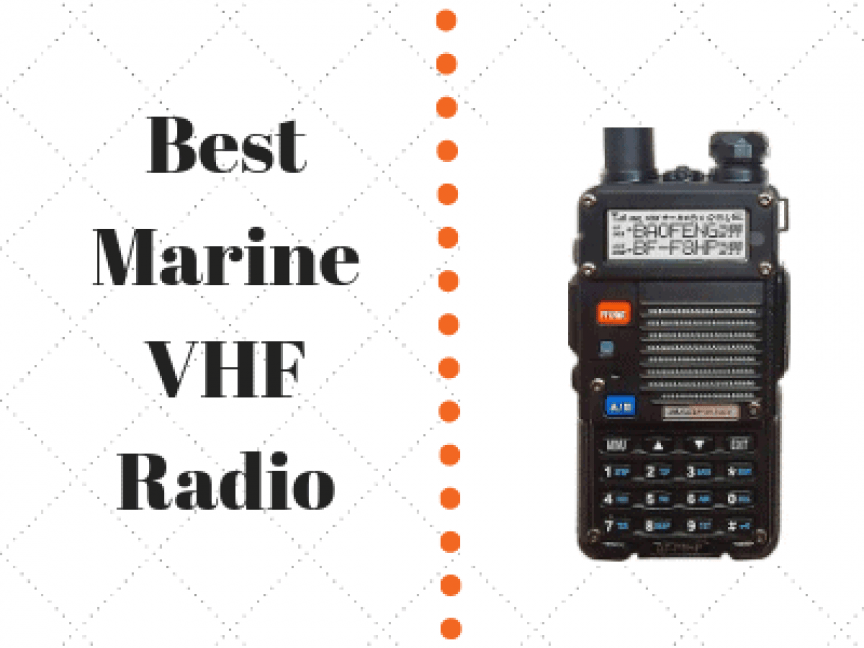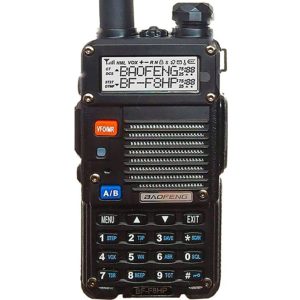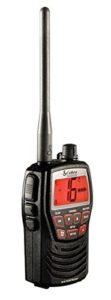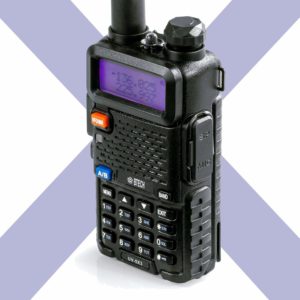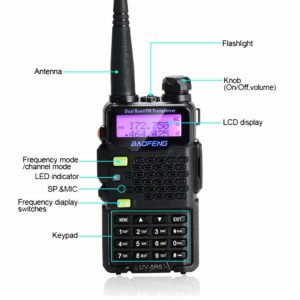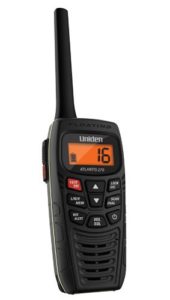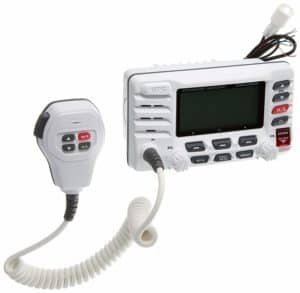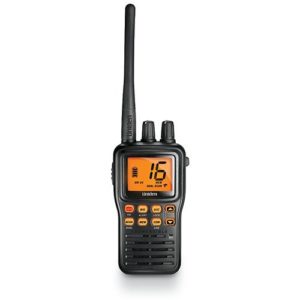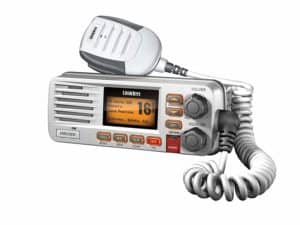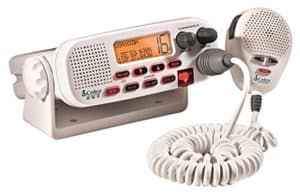Have you ever been out on the water but were unable to communicate with other people for whatever reason? Having the best marine VHF radio on hand for your use can make a world of difference. You might have been concerned because you were unable to reach people all the way out in the middle of the water.
A marine VHF radio works with Very High Frequencies. These radio waves are from the 30 to 300 MHz range and are typically used for television and broadcast radio purposes. The sounds produced are a little clearer, what with the VHF signals offering more support for added information.
You can get this to work well for when you are trying to communicate with people in the event of an emergency. You can also use this to get in touch with authorities for any other kind of help or even to communicate with people on land. The radio community is so large that it will be very easy for you to get more out of any chats you want to get into. This is an attractive point that you are bound to love taking advantage of.
What is the right marine VHF radio for your use?
You have to be fully aware of what you can do when getting your radio up and running. After all, you will need to use this if you want to communicate with someone in the event of an emergency or other significant threat.
As this guide shows, you can find the best marine VHF radio for your use by looking at a few points that are not too hard to follow. Using the correct considerations can make a world of difference as you look for something that helps you to get in touch with someone. It is always good to see how well such a setup is organized and that there are no problems with what might come about.
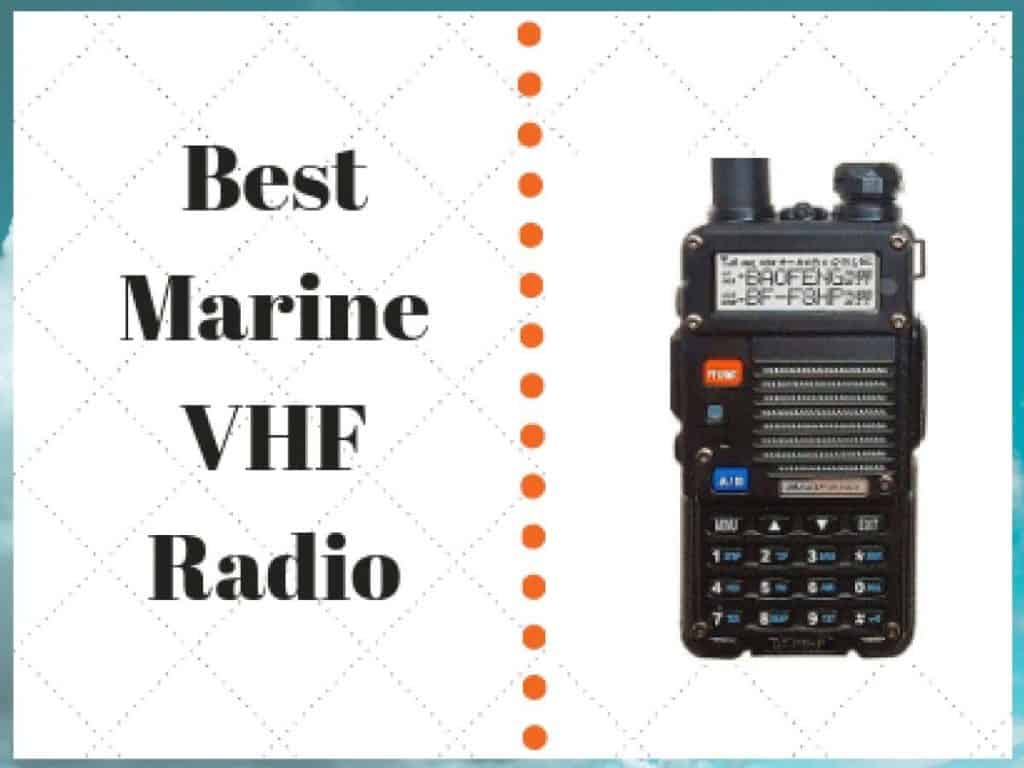
This guide focuses on both of the main types of marine VHF radios you can use. You can work with a traditional handheld option that works with a battery that you can recharge on your own. You can also work with a set-top box that has a longer range and is fixed within a certain spot in your boat. No matter what you choose, you should look at how you are going to use it and that you have a good plan on hand for making your marine VHF radio work for your demands.
Comparison Table For The Best Marine VHF Radio
|
Model |
Output (in watts) |
VHF Frequency Range (in MHz) |
Typical Battery Life (in hours) |
Check On Amazon |
|
BaoFeng BF-F8HP |
1, 4 or 8 |
136-174 |
18 to 24 |
|
| Cobra MRHH125 | 1 or 3 | Not available | At least 24 | Check On Amazon |
|
BTECH UV-5X3 |
1, 4, or 5 |
130-179.99 |
18 to 24 |
|
|
BaoFeng UV-5R5 |
1 or 4 |
136-174 |
12 |
|
|
Uniden Atlantis 270 |
1, 2.5, or 6 |
N/A |
10 |
|
|
Standard Horizon GX1700W |
25 |
130-179.99 |
Works off of the boat’s power |
|
|
Uniden MHS75 |
1, 2.5 or 5 |
136-174 |
12 |
|
|
Uniden UM380 |
25 |
130-179.99 |
Works off of the boat’s power |
|
|
Cobra Electronics MR F45-D |
1 or 25 |
136-174 |
Works off of the boat’s power |
|
|
Standard Horizon HX890 Handheld VHF |
1, 2, or 6 |
N/A |
11 |
|
| Icom M330G 31 Compact Basic VHF with GPS |
1/25 |
N/A |
Works off of the boat’s power | Check On Amazon |
Quick Answer: Which is The Best Marine VHF Radio?
Our quick answer is BaoFeng BF-F8HP VHF marine radio. You have to look at a few great options for when you want to find a good marine VHF radio. There are many popular choices that can be worthwhile and should be explored in a sensible way.
Be advised though that each of the options you can work with is all varied items based on many factors and should be explored in careful detail.
Here is our list:
- BaoFeng BF-F8HP
- Cobra MRHH125
- BTECH UV-5X3
- BaoFeng UV-5R5
- Uniden Atlantis 270
- Standard Horizon GX1700W
- Uniden MHS75
- Uniden UM380
- Cobra Electronics MR F45-D
- Standard Horizon HX890 Black Handheld VHF
BaoFeng BF-F8HP
The first option to see for the best marine VHF radio is the BaoFeng BF-F8HP. This is a VHF and UHF-enabled model, thus making it a dual-band choice. It uses three separate power levels and a battery that can last for at least 18 hours depending on how you use this.
This uses a high gain 7-inch antenna that provides you with twice the performance of a typical model. You can also choose a narrow band if you need to reach smaller areas.
The button layout lets you adjust the frequency on the radio. This also gives you a digital readout to help you see what frequency you are using. You can quickly shift from one frequency to the next when you get this organized well enough.
The unit also gives you a powerful microphone with noise-canceling features. This works well for keeping your voice in control without causing it to break apart when you are communicating with someone. But you should still watch for how well you speak into the microphone and that you are courteous without being too aggressive while speaking.
Pros
- Offers a clear sound
- The antenna offers a sizeable range
- The battery does not need to be charged often
- Works well on low and high power settings alike; choose your setting based on how far out you might be from others
Cons
- The display is tough to figure out at times
- Buttons are rather small in size
- The antenna could stand to be a little longer; BaoFeng does offer extensions
Check Availability & Customer Reviews On Amazon
Cobra MRHH125 3-Watt Waterproof
Another good choice among the marine VHF radio options, this model from Cobra has a versatile layout. It uses one and three-watt setups with ease. It can also reach NOAA and weather stations while linking up to various channels. It uses individual settings for American and Canadian VHF channels as well as some international channels.
The LCD screen offers a clear display. It shows the channel you are on. It also offers a backlit feature.
Cobra recommends this VHF radio as a choice for small vessels. It is also suitable for larger boats as a backup material for when the power in space runs out.
You can even select a beep tone on the unit if desired. This can be turned on or off. You can use this to let you know when any messages you are trying to transmit have been received.
A weather alert system is also included as it reads NOAA signals. It can create a tone when a weather emergency or threat is coming into a spot.
Pros
- Lets you scan channels to find conversations as they are going along
- Easy to switch from one wattage level to another
- Comes with a useful microphone jack for helping you get transmissions handled
- Noise-canceling microphone keeps background noise from being a threat
Cons
- Works with a shorter transmission range
- Intended as a backup if you have a larger boat
- Can handle water splashes but does not do well when submerged
Check Availability & Customer Reviews On Amazon
BTECH UV-5X3
This is a tri-band radio that works with not only VHF and UHF signals but also with Ham radio signals for getting in touch with amateur radio users. The Ham radio support makes it so you can reach people even when signals from other traditional radio towers are not working.
You can save multiple channels on your radio as pre-sets. These can be programmed through a button on the side of the radio unit.
This uses support for up to five watts of power at a time. It can also work with an extended variety of VHF frequencies with the ability to divide up those frequencies by 0.01 MHz at a time. You can use this to figure out the power you are using at a given time, thus giving you more control over how well you are interacting with someone.
This also uses a noise-canceling feature on the microphone. This helps you with getting in touch with people in a crystal clear fashion and is very easy to work in any situation.
Pros
- Works with many frequency steps
- Can handle a variety of power setups
- The simple display tells you what frequency you are working with at a time
- Weighs about eight ounces
Cons
- The attachable antenna might be too flexible
- Takes a bit for the rechargeable battery to power up all the way
- Takes a while for you to scan the entire network
Check Availability & Customer Reviews On Amazon
BaoFeng UV-5R5
It is often frustrating to try and go through the entire range of frequencies that you want to look through when finding signals. The BaoFeng UV-5R5 works in that you can set a series of parameters for the radio signals you want to search through at a time. You can do this to zero in on a specific series of frequencies you want to reach. As you use this, you can get up to 128 channels programmed.
You can also search for frequencies within 0.025 MHz at a time. This is good for finding precise and very specific signals depending on where you are going.
This all works with a 12-hour battery that can be recharged with a simple desktop charger. It can get everything charged up in just a few moments.
Pros
- Works with extremely precise readouts
- The LED flashlight makes it easier for you to find things outside
- Fits well into a shirt pocket
- Displays two separate frequencies based on the settings being used
Cons
- Buttons are rather small in size
- The antenna can wear out quickly in rough weather conditions
Check Availability & Customer Reviews On Amazon
Uniden Atlantis 270
Uniden Atlantis 270 VHF marine radio is pre-programmed with all NOAA weather channels. It works easily with all USA/Canada or international marine channels. This two way, small, handheld, floating marine VHF radio is made to maintain submergible waterproof standards. The display is clear and easy to handle at night or daytime. The display size is 18mm by 37 mm.
This Super marine radio resists 30 minutes without a problem up to 1 meter of water. If it is in the water, just clean and shake the radio to reuse. If the radio is submerged in the salt-water, clean it with fresh water and dry it before using it again.
Pros:
- NOAA weather channels
- Meets IPX7 & JIS7 submersible waterproof standards
- Easy to use backlit LCD display
- Power boost key
- AC/DC adapters are included
- The radio comes with a charging cradle.
- Different 1 / 2.5 / 6 watts emit power can be selected.
Cons:
- The charger is not waterproof
Check Availability & Customer Reviews On Amazon
Standard Horizon GX1700W
Standard Horizon made this model as a choice that makes it easy for you to communicate with others. This offers a set-top design that lets you communicate with other people from a box that links off of your boat’s engine power.
The three-inch LCD screen offers a nice layout that makes it easier for you to find a frequency and to keep things tuned well enough. The knobs on this model let you switch from one setting to the next. You can save individual frequencies by pressing the appropriate knobs.
The handheld unit that you would talk into features, a series of buttons that makes it easier for you to communicate with people. You can press the button on it to talk to others.
A few control buttons are also used to help you tune from one channel to the next. The bright red button also lets you get to the 9 or 16 channel for you to get in touch with an emergency channel immediately if necessary.
One point about this model that makes it a little different from other radios is that it comes with GPS support. You can press the GPS button on the top left part of the unit to activate the GPS readout.
This then lists information on the surroundings in your area. The simple design also lets you save different waypoints as necessary, thus letting you keep tabs on where you are going while on the water.
This even provides approximate totals for how far you are from some of the waypoints as you move along the water.
Pros
- Works with more power than other models
- The convenient case does not let in water
- Supports up to a hundred GPS waypoints
Cons
- Does not have a backup battery
- Requires an extensive amount of effort for getting it installed properly
Check Availability & Customer Reviews On Amazon
Uniden MHS75
Another great choice for your use is the Uniden MHS75. This offers a fully submersible body that can float on water. It also works with a battery that runs for about twelve hours at a time on a full charge.
The VHF band supports up to a hundred locations in its internal memory. The arrow buttons let you switch from one location to the next.
You can monitor two Coast Guard channels at a time. These include channels for hailing for assistance and another one for distress signals. You can also get access to weather channels in your local area. The radio can be programmed to give you alerts for cases where there is a weather emergency about to come about in an area.
The 1, 2.5, and 5-watt systems on this let you adjust the power on the unit to let you get in touch with people within certain ranges. The setup also makes it easier for you to adjust the wattage being used. Of course, this feature works primarily for helping you to adjust the amount of battery power being used at a given time.
Pros
- Battery recharges fast
- Backlit display makes reading what is on the radio very easy to do
- Channel scanning feature can save individual channels so you don’t have to scan many times over
- Works with all American, Canadian, and international marine channels
Cons
- Not many controls on the unit itself
- The battery does not last as long as what you might find on some other models
Check Availability & Customer Reviews On Amazon
Uniden UM380
This is also a model from Uniden that can work well for your communication requirements. This is a set-top unit that you can add to the power supply on your boat.
A GPS feature is also included in this unit. This lets you know what the specific GPS coordinates of your boat are. This is useful if you have to send out a distress signal and you need to get people to know where your boat is located.
The Digital Selective Calling feature lets you press a single button to send out for help during an emergency. You can use this to send out information on your boat’s position based on what the GPS readout shows.
The SAME Weather Alert system is another popular part of this model. When a weather emergency comes about, you will get a code based on your location to let you know what emergency issues are coming and how far it is from you. This should give you enough time for planning when you are going to get out of a spot.
Pros
- Compact body fits in well on most parts of your deck
- You can assign names to individual marine channels
- 3.5mm audio jack lets you plug an outside speaker into the unit’s body
Cons
- The handheld part of the unit does not have as many buttons to work with
- GPS data does not offer a graphic layout
Check Availability & Customer Reviews On Amazon
Cobra Electronics MR F45-D
This next option is another fixed-mount model. It works with 25 watts of power and uses all major international channels. It also comes with a DSC audio log that captures information on all the signals you get in touch with plus whoever might attempt to get in touch with you. You can set presets for those channels for when you are trying to reach other people in a spot.
The GPS support helps you to quickly find your coordinates. You can also work with one of ten different NOAA weather channels while collecting weather alerts automatically. The unit responds to such emergencies quickly.
The receiver unit that you talk into comes with buttons that work for reaching emergency channels plus buttons to let you go from one channel or preset to the next. The clear body also comes with a sound canceling setup to ensure you can quickly let people know about things that are happening where you are.
In addition to the 25-watt power setup, you can also work with a 1-watt layout if you are trying to talk to someone a little closer. The layout zeroes in on the setup to ensure it is not hard for you to communicate with someone.
Pros
- Comes with the external speaker jack
- Noise cancellation helps you transmit your messages with ease
- The simple layout can be tilted up or down
Cons
- Needs extensive installation in your boat for it to work
- Takes a bit to switch from the 1-watt to 25-watt layouts
Check Availability & Customer Reviews On Amazon
Standard Horizon HX890 Black Handheld VHF Radio Review
The last option to take a look at is another handheld model that you would love to use in your boat. This Standard Horizon model has a W 2.6 x H 5.43 x D 1.5 inches dimension. It comes with a rechargeable lithium-ion battery, battery tray, charger, adapter, battery cradle, cable for pc programming, etc.
This waterproof model comes with submersible and floating capacity. It has a loud audio system and it can cancel unwanted noise. It transmits output in 6, 2, or 1 watt.
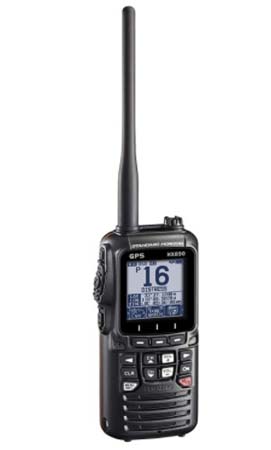
A built-in GPS receiver, NOAA weather channels with alerts, man overboard attribute, etc make this unit a military standard device.
Pros
- The model is waterproof and comes with a three years waterproof warranty
- We can easily use it during the day time or at night changing the day or night mode
- FM broadcast band receiver makes the device more complete
- The unit delivers loud and clear sound
- It can be used for 11 hours without charging the lithium-ion battery
Cons
- We can charge this VHF radio only on the charging cradle.
Check Availability & Customer Reviews On Amazon
Buying Guide
There are many points relating to the best marine VHF radio for your use that you have to look at. These are vital points that show how well a radio can work and what makes it different for your needs. These are all good points to see regardless of whether your unit comes with a fixed setup layout or a handheld layout.
Wattage
The total wattage on your VHF radio refers to how far you can get your signals out. About one watt should equal a little less than one nautical mile of range. A single nautical mile is equal to about 1.15 miles.
When you have more wattage, it becomes easier for you to reach people. Many radio models let you adjust the wattage based on the need you have for it. You can use a lower wattage when you are close to other people, for instance. This is vital considering how the radio will use more battery power if the wattage is turned up by a bit.
Display
A basic display will be found on your radio. This should give you a digital readout of your frequencies, channels, and other features. It should also come with a battery gauge to let you know how much power is left.
It can also give you details on your GPS location if necessary. Some VHF radios come with more detailed layouts that offer graphic reviews of what is in a spot, but it is not all that easy for you to find a graphic display in some cases. Be aware of this when getting a good radio layout to work for you.
Squelch
You might notice that there are two knobs on many of the marine VHF radio models. The first is a volume knob while the second is a squelch knob.
The squelch works to stop the receiver from taking in output if the signal strength is too weak. That is, you will keep from hearing things off of radio signals that are not producing enough information.
You can use this to ensure you only get communications from those who are near you and are easy to get a good hold of.
The intensity of the squelch knob can determine the threshold that you are working with when adjusting how well the sounds are being managed. You can use this to quickly tune out the weakest channels that might make it harder for you to hear what you are really trying to get access to.
The risk of signals bleeding over one another will be reduced. You also have the option to keep the squelch level down so you can try and find a far off frequency that you might want to get a little closer to.
Be advised that the squelch knob is more likely to be found on set-top boxes than on some of the more traditional options you can come across including the handheld options available.
Ease of Handling
It should be very easy for you to hold onto your VHF radio. A good radio can come with an ergonomic body that fits in your left or right hand alike. Some models even come with belt clips to help you hold onto something. Don’t forget to look at the nice buttons on the radio to see how well it works.
You should also look at how well you can program many channels onto your radio. Some of the buttons on the radio will let you move from one channel to the next after you have gotten it all prepared right. Make sure you look carefully at how well this works so you will get more out of your work.
Range
The range on your antenna is important, but it is even more important to look at the intervals that you can work with. A quality radio can handle a range that works with multiple signals at a time.
It can also work with very small intervals of 0.025 MHz in some cases, thus giving you a more precise measurement for getting the most accurate layout possible.
Waterproof
You would have to look carefully at how well a marine VHF radio can handle water. The marine VHF radio you can use should be fully waterproof in that it can continue working even if you drop it in the water off of your boat. A unit should also float well on the water.
Fortunately, most marine VHF radios are light in weight to where they will carefully float on the water if you drop it. This makes it easier for you to retrieve it in the event you accidentally drop it.
You will typically come across one of three measurements when finding a waterproof VHF radio:
- Submersible – This can be submerged in water and will handle most conditions. However, it might not work well when you get it in touch with water jets.
- IPX7 – The device will keep working even if you drop it in water. However, it might stop working if the unit goes deeper than three feet into the water.
- IPX8 – This is the best measurement in that it can handle water deeper than three feet.
GPS Receiver Functionality
Some of the more useful marine VHF radio models out there come with GPS functionality. This works in emergencies when you need help with finding your location.
A screen would list information on your coordinates at this point. It is useful, but it should be something that you can turn on and off on your own. This feature can use more power than what you might be comfortable with. People who love marine activities may find interesting our post about the best fish finder GPS combo.
Antenna
The antenna should be tall enough to give you enough coverage while making it easier for your transmissions to be sent out.
The antenna can stick out by a few inches at a time and should be rigid so it will not be harder for you to utilize. It must also be fully covered so it will not wear out or have any of its parts exposed.
Handheld or Fixed Mount?
You typically have one of two options to work with when finding the correct marine VHF radio. You can get a handheld design that can be carried around and will not need any external power for it to work. This could work even when the rest of the power on your boat goes out, thus making it vital in the event of such an emergency.
You can also work with a fixed mount model. This would work with more power at a time, thus making it easier for you to reach further distances. But this would also work alongside any power source that your boat might run off of.
Having a backup battery on a fixed mount radio is best so you at least have a bit of power to work in the event that the power on your boat runs out. Be advised though that the battery backup feature on one of these models might be rather minimal based on how much time it can work for.
Battery Life
The battery life of a marine VHF radio can vary based on what you use. You will not be able to get any traditional batteries added or replaced inside your VHF radio.
Rather, the VHF radio will work with a battery that is built-in and has to be charged up. Some models can last for fifteen hours at a time or more. Check on how well your battery can work before using the radio.
Make sure you conserve your energy when using the battery as well; you do not want to use more unnecessary features to the point where the unit will stop working prematurely.
Speaking of charging units, you might come across one of many options for charging your battery. You might have the ability to link a radio up to a 12V DC outlet like what you might find in your automobile.
You can also find some desktop charging units where you would place the radio into the outlet to let it charge up for a bit of time.
Weight
Most marine VHF radios are made with lighter weights that are around eight to twelve ounces in size. Some larger units might come with more features and more powerful antennas.
Heavier choices might use more energy and will have shorter battery lifespans as well.
Presets
The odds are you will come across a few channels that you will want to get back to when you are communicating with people through your VHF radio.
A model needs to work with plenty of presets where you can get in touch with people at certain frequencies. Some models let you associate certain presets with particular channel numbers, but the functionality will vary. Also, you should be able to handle dozens of locations at a time.
Weather Alerts
It always helps to get the proper weather alerts from a marine VHF radio in the event there are issues outdoors. A weather alert feature should work by letting you know when the NOAA sends out a warning signal.
The NOAA will send a trigger out within its messages to let such radios know that a particular emergency is about to come along. You can use this to learn about tornados, thunderstorms, or other significant emergencies that might come about.
You should watch for how well the SAME or Specific Area Message Encoding features on your radio work though. The SAME system analyzes the location of the emergency or other messages.
This ensures that you only receive messages that are relevant to your local area. You will not get any messages that are only good for people within certain regions that might a little further off from where you are located.
Frequently Asked Questions
How well should an antenna on a marine VHF radio be positioned?
You must keep the antenna on your radio as high up as possible. The VHF waves produced work on a line-of-sight pattern. This means that the signals are not going to flow alongside the earth’s natural curves. When the antenna is a little higher up, it becomes easier for you to get your signals out a little further.
How would the GPS feature on your radio work?
The GPS feature would focus on identifying your physical location based on the specific geometric coordinates that are read by the satellites that make up the GPS layout.
You can use this to let people know where you are in the event of an emergency. When you send out a distress signal, a person will identify your location and get help out to the appropriate space. This ensures you are properly served as soon as possible.
How can you use DSC?
Digital Selective Calling, or DSC, is a feature that works on many of the marine VHF radio models around. This lets you list information on who you are and your location.
This works if you have registered for the DSC system and if your radio can actually handle the process. A nine-digit MMSI number must be used so you can get information on your vessel out to a larger database.
You can go online to get your number ready and to have it linked up to the proper boat that you are using. It is best to get this working quickly so it is not too hard to make it all work outright.
How is the battery power measured on your radio?
The battery power that is listed on your radio relates to a certain number of hours that the radio can work for.
However, this is based on a 90/5/5 ratio. 90 percent of the radio’s usage will be on standby where it is on but not receiving anything. 5 percent is for messages that you are receiving while the other 5 percent is for messages you are sending out.
What channels can you use in your local area?
One reason why many people use marine VHF radios comes from how they can handle many channels. You can use one channel to ask for someone to open a bridge for you if there is one in the way of your boat.
Meanwhile, other channels might be used in an area for different communication needs. You would have to go online to find information on the specific channels that are used in your local area. This gives you an idea of how well communication standards are utilized in a certain space.
You can use channels 67, 68, 69, and 72 when you are trying to chat with others who are using their vessels for recreational use. These channels are recommended as they will not get in the way of any informational, commercial, or emergency channels. The adequate marine VHF radio will make it easier for you to tune in to one of these channels quickly.
How can you use one of these radios in the event of an emergency?
You can get a radio set up to channel 9 or 16 in the event of an emergency. Some radio models let you immediately switch to one of these two channels for emergency purposes. This assists you by producing a clear and easy to follow layout for handling a call.
Channel 16 may also be used if you are trying to get in contact with someone. However, you would have to move to another working frequency after you get in touch with someone from that setup.
Why do you need access to channels from different countries?
All countries have their own channels for use. That is marine channels in the United States work with frequencies that are different from what is used in Canada and so forth.
A radio that can handle as many of these frequencies and signals as possible is important to have. You can check online to see what channels are available for your use in any situation.
Are there any bits of etiquette that you would have to use when using a marine VHF radio?
You will have to ensure you use the radio when you need to without trying to add more words than needed. For instance, when you use the radio, you would have to call someone by addressing a boat or location and then listing your name and call signal to get in touch with someone.
You should avoid trying to call someone for more than 30 seconds at a time. You would also have to wait two minutes in between the first three tries to contact someone if necessary. Meanwhile, you would have to wait for about 30 minutes after that failed third try to get in touch with that person once again.
How would you go about installing a marine VHF radio if you have a set-top box?
Although you can always use a handheld marine VHF radio, adding a larger set-top model might be best if you are trying to get in touch with people from far off distances. But in this case, you must be careful when trying to get it installed.
You would have to link this up to any power outlet that your boat comes with. Also, the power outlet might be linked to a larger battery on the inside of your boat. The installation standards should vary based on your boat, so check your boat’s manual for details on how to get such a material installed properly.
When should you get a handheld model versus a set-top choice?
The main point to use when deciding what the best marine VHF radio for your use would be is to think about how far off you are going to communicate with someone.
A handheld option is best for when you are going out on a smaller body of water and you know that there are things in your local area. This comes as a handheld model that will work with up to ten miles of coverage at a time. Meanwhile, a set-top option could work with a range of around 30 miles in some cases.
You should also stick with a set-top model if you have a larger boat to work with. This includes a boat with a big enough battery to let you get the unit working well enough.
You can still get a handheld model to work for your needs as a smaller portable option and as a backup in the event that the original set-top model you are working with is not operational or has stopped for whatever reason.
What is the optimal operating temperature for a radio?
A good radio should work in a majority of conditions. It can work in freezing conditions as well as in humid situations. But it is typically best to use the radio at conditions from 60 to 75 degrees Fahrenheit so it is easier for the radio to stay working and for signals to move along in the air well enough.
Conclusion
Having a quality marine VHF radio is vital for when you get out there on the open water. You are going to need to find a way to communicate with people while on the water, but you need to look at what you can use at any given time. Be advised over what you can find when getting a good radio up and running for any intention.
The best marine VHF radio for your use should be something that is easy to work with and is not going to be too hard to utilize. Make sure you find something that is not hard to set up and that it only takes a few moments for you to get it ready.
Look at your plans for a fishing trip too so you can find a model that will not run out of power before your trip comes to an end. Be aware of how well your model can work as well so it is not hard for you to get the most out of your communications with other people in any situation.

